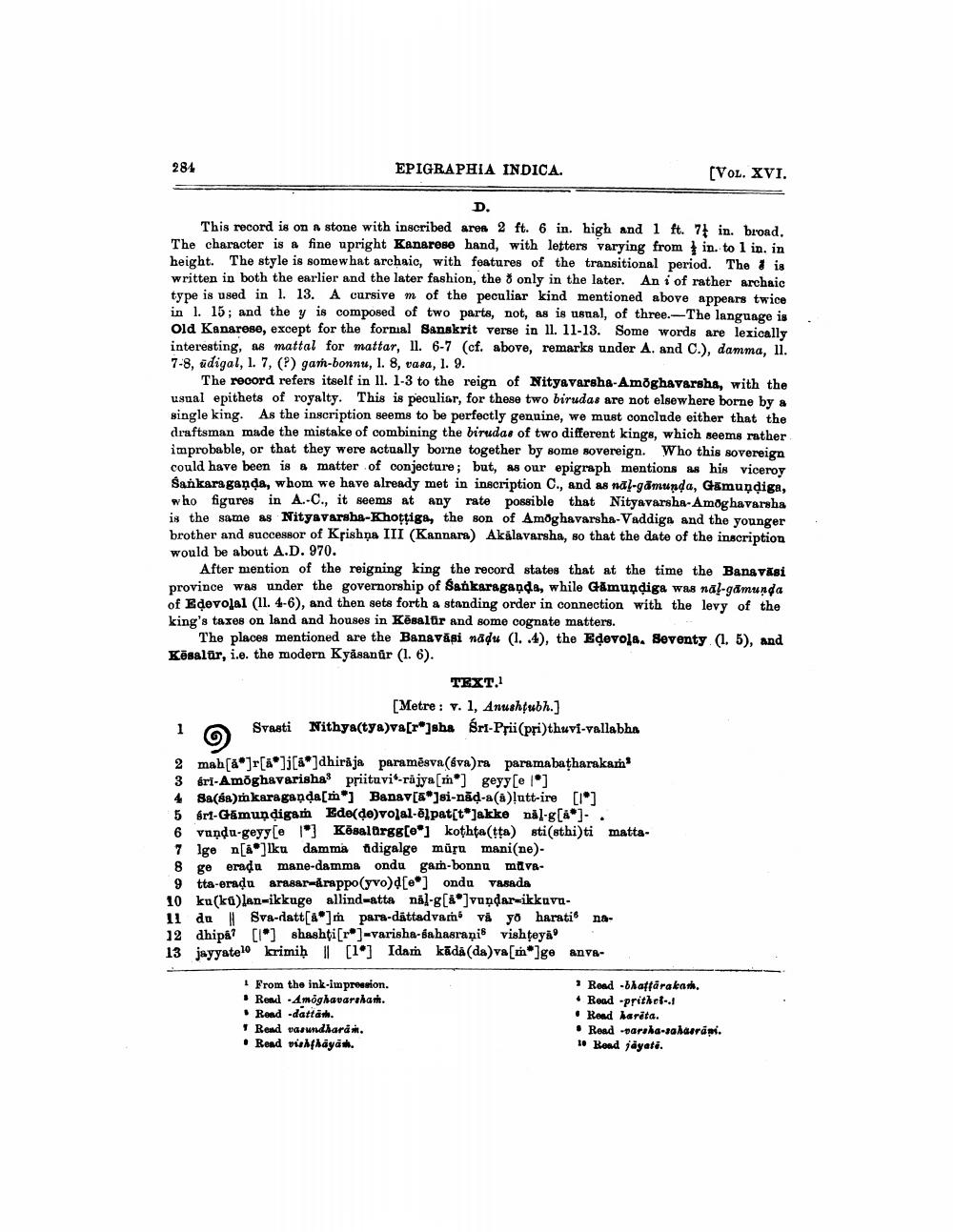________________
EPIGRAPHIA INDICA.
(VOL. XVI.
D. This record is on stone with inscribed ares 2 ft. 6 in. high and 1 ft. 74 in. brond, The character is a fine upright Kanarese hand, with letters varying from in. to 1 in. in height. The style is somewhat archaic, with features of the transitional period. The 1 is written in both the earlier and the later fashion, the only in the later. An i of rather archaic type is used in l. 13. A cursive m of the peculiar kind mentioned above appears twice in 1. 15; and the y is composed of two parts, not, as is usual, of three.-The language is Old Kanarese, except for the fornial Sanskrit verse in 11. 11-13. Some words are lexically interesting, as mattal for mattar, 11. 6-7 (cf. above, remarks under A. and C.), damma, 11. 7-8, ūdigal, 1. 7, (?) gam-bonnu, 1. 8, rasa, 1. 9.
The record refers itself in 11. 1-3 to the reign of Nityavarsha-Amoghavarsha, with the usual epithets of royalty. This is peculiar, for these two birudas are not elsewhere borne by a single king. As the inscription seems to be perfectly genuine, we must conclude either that the draftsman made the mistake of combining the birudas of two different kings, which seems rather improbable, or that they were actually borne together by some sovereign. Who this sovereign could have been is a matter of conjecture; but, as our epigraph mentions as his viceroy Sankaraganda, whom we have already met in inscription C., and as nal-gámunda, Gamundiga, who figures in A.-C., it seems at any rate possible that Nityavarsha-Amoghavarsha is the same as Nityavarsha-Khotiga, the son of Amoghavarsha-Vaddiga and the younger brother and successor of Krishna III (Kannara) Akälavarsha, so that the date of the inscription would be about A.D. 970.
After mention of the reigning king the record states that at the time the Bana visi province was under the governorship of Sankaraganda, while Gamundiga was nal-gamunda of Edevolal (11. 4-6), and then sets forth a standing order in connection with the levy of the king's taxes on land and houses in Kēsalir and some cognate matters.
The places mentioned are the Banavāsi nadu (1. .4), the Edovola, Seventy (1. 5), and Kēsalür, i.e. the modern Kyåsanur (1. 6).
TEXT.
[Metre : v. 1, Anushubh.] 1 o Svasti Nithya(tya)va[r*]sha Śri- Prii (pri)thuvi-vallabha 2 mahla]r[A]j[]dhiraja paramēsva(sva)ra paramabatharakam 3 gri-Amoghavarisha: priituvi -rajya[m] geyy[e 1] 4 Ba(sa) karaganda[] Banav[&]si-nād-a(a)!utt-ire [1] 5 Sr-Gamundigam Ede(de)volal-ēlpat[t]akke nål-g[A].. 6 vandu-geyy[e 1 KosalOrg [eo] kothta(tta) sti(sthi)ti matta7 lgen[]lku damma adigalge musu mani(ne). 8 geerada mane-damma ondu ganh-bonnu move9 tta-eradu rasar-&rappo(yvo) d[e] ondu vasada 10 ku(k)lan-ikkuge allind-atta nál-g[8]vundarwikkuvu. 11 da v a-datt[a] para-dättadvam vs yo harati na 12 dhipa? (I) shashti[ro]-varisha-sahasrani vishţeya 13 jayyata krimiḥ 11 [1°] Idam kādā (da)va[m]ge Anya
From the ink-impression. Real Amoghavarshan. Read -dattath.
Read vasundharau. . Read viskfhayat.
* Read - Shaffarakat. • Read -pritke.! • Read harita. • Read -paraha-sahasrani. 10 Beod jagati.




